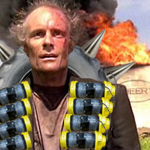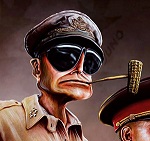|
So I have become interested in the Korean war as of late an was wondering if anyone had any recommendations of books on the war, particularly memiors though regular historical accounts are fine too.
|
|
|
|
|

|
| # ? Jun 1, 2024 19:10 |
|
I was actually wondering simultaneously to it being asked how pike combat had compared to phalanx. So I had some questions on the topic too.WoodrowSkillson posted:he is really bad at not stopping at the point he intended. in that one, what he is trying to say is it was relatively rare for pike formations to charge at each other full bore, as the intended strategy of the battle. Does this imply then that pikes generally slowed down combat so that the commanders got enough time to plot and set up maneuvers? If they don't go for the quick charge, then I would assume it becomes a game of, well, poking and flanking.
|
|
|
jadebullet posted:So I have become interested in the Korean war as of late an was wondering if anyone had any recommendations of books on the war, particularly memiors though regular historical accounts are fine too. Pro-tip: Matthew Ridgway was a loving boss.
|
|
|
|
|
jadebullet posted:So I have become interested in the Korean war as of late an was wondering if anyone had any recommendations of books on the war, particularly memiors though regular historical accounts are fine too. The US army has made "Policy and Direction: The First Year" available online here which as its name suggests, covers the first year of the war.
|
|
|
|
jadebullet posted:So I have become interested in the Korean war as of late an was wondering if anyone had any recommendations of books on the war, particularly memiors though regular historical accounts are fine too. I like This Kind of War by Fehrenbach. It's dated, but I enjoyed it a lot.
|
|
|
|
Do they teach any appreciable amount of unarmed combat in modern armies?
|
|
|
|
WoodrowSkillson posted:what hegel has probably already elaborated on and i have forgotten is how often long, protracted pike combat happened. I know "bad war" was coined for particularly nasty pike combat, but from things like the english civil war i know that often once the push of pike happened, one side retreated relatively quickly. Rocko Bonaparte posted:Does this imply then that pikes generally slowed down combat so that the commanders got enough time to plot and set up maneuvers? If they don't go for the quick charge, then I would assume it becomes a game of, well, poking and flanking. And there's lots of things an infantry formation can do. You can attack other infantry physically, you can shoot them, you can repel an attack by other infantry, you can repel an attack by cavalry, you can take and hold a particular spot, etc. It's not just charging other infantry like a pair of bucks. HEY GUNS fucked around with this message at 20:51 on Feb 17, 2015 |
|
|
|
Frostwerks posted:I would love a massive effortpost on the middle east in the world wars but especially the first one. *polite cough* 100 Years Ago Herbert Sulzbach is starting to get fed up as the shelling continues. The French attacks have already devolved into marching on Berlin six inches at a time. Meanwhile, a multinational force arrives to help British troops regain control of Singapore, and the mutineers are sent on the run. And, in London, someone has worked out what will be required to win the war, and takes out an advert in the Daily Telegraph to promote his lecture. Has the War Office been told? vvv My favourite bit in Asterix is when Caesar can't invade Britain properly, because they keep stopping to drink hot water with milk in and they all go home at weekends vvv Trin Tragula fucked around with this message at 21:10 on Feb 17, 2015 |
|
|
|
HEY GAL posted:Prooooooobably it was relatively quick. I'm also thinking of the English Civil War battle where they closed to pike distance, stabbed at each other for a while, and then for some reason both sides stopped, the pikemen set their pikes upright in the earth and the fendriches did the same with their flags, and everyone just stood there staring at each other for a while. That was the "English" phase of the battle, often misunderstood by continental historians. "Well I'll say old bean, that was a right proper squabble, very sporting" "Why thank you old chap, I must say you did quite well for yourself" "Oh not at all, we are all really quite amateurs at all this" "No I insist, you have been perfect gentlemen" Etc. until one side has had enough or the tea runs out.
|
|
|
|
ArchangeI posted:"Oh not at all, we are all really quite amateurs at all this"
|
|
|
|
SquadronROE posted:Do they teach any appreciable amount of unarmed combat in modern armies? Fairbairn and Sykes assembled some good stuff in WW2. Just a few things to get people up to speed.
|
|
|
|
ArchangeI posted:That was the "English" phase of the battle, often misunderstood by continental historians. We didn't have tea in the 17th century; hadn't conquered India yet, see. Coffee was the happening drink of the moment 
|
|
|
|
HEY GAL posted:I'm not sure what you mean. Can you say more? I also expect a Renaissance army to have evolved tactics since the time of Roman phalanx, so what were they doing different? I was just assuming that the pikes served to repel penetration so that the muskets could do their thing safely. Like, compared to two sides of random hordes with face paint smashing into each other, a fight with spears and pikes has to look glacial. With the muskets, am I wrong? Was it quite dramatic? I'd expect a slower pace helps the general on the field figure out what's going on and react. Sure, the cavalry have their own opinion, but I think that just goes to highlight their differences more and make combining them with your infantry a much more sophisticated exercise. So my question was if pikes more strategically gave the army time to react and respond. I wouldn't expect anybody of the time to necessarily observe that, but I would expect that there was a rise in more sophisticated maneuvers. I wouldn't know because all I really ever see from Wikipedia summaries of wars of that time are really devoid of those kinds of details. Some dudes with different interpretations of Christianity got together, bopped their chests, and one side or another was left afterwards.
|
|
|
feedmegin posted:We didn't have tea in the 17th century; hadn't conquered India yet, see. Coffee was the happening drink of the moment Or prayer if you were the other guys.
|
|
|
|
|
Trin Tragula posted:...And, in London, someone has worked out what will be required to win the war, and takes out an advert in the Daily Telegraph to promote his lecture. Has the War Office been told? Well, to be fair to the guy, there were some pretty "great world changes" following the end of the war. They probably weren't the super apocalyptic ones that he had in mind, but I imagine that if you were a high and mighty sort in one of the empires that got carved up afterwards, they might as well have been. What I'm saying is, if he were around today, he'd have giant banner ads calling himself "the Christian Scientist who foresaw the fall of four empires!"
|
|
|
|
Pyle posted:Bayonet fencing was regular practice in all armies until last few years. It was discontinued as a physical exercise when the bayonet fell out of fashion. I don't know about anyone else, but the British army still uses bayonets.
|
|
|
|
Rocko Bonaparte posted:I couldn't say/ask much more without sounding really stupid. Back to the beginning: I am also interested in how we still had pike's in the Renaissance and how that had evolved from basically the phalanx. The conversation was steering towards pike-on-pike combat being less about locking together. Compared to what I know of traditional phalanx-on-phalanx combat, that is one thing that would be quite different. Wasn't it true that Hellenistic combat often came down to phalanx shoving matches? There is no unbroken line of evolution from the Makedonian phalanx to the Renaissance.
|
|
|
|
Rocko Bonaparte posted:I couldn't say/ask much more without sounding really stupid. Back to the beginning: I am also interested in how we still had pike's in the Renaissance and how that had evolved from basically the phalanx. The conversation was steering towards pike-on-pike combat being less about locking together. Compared to what I know of traditional phalanx-on-phalanx combat, that is one thing that would be quite different. Wasn't it true that Hellenistic combat often came down to phalanx shoving matches? But it's not "still"--it's "again." The mounted rider was the hot poo poo during the Middle Ages, and it was in response to that that the Swiss developed the pike square, the predecessor of 17th century infantry blocks. quote:I also expect a Renaissance army to have evolved tactics since the time of Roman phalanx, so what were they doing different? I was just assuming that the pikes served to repel penetration so that the muskets could do their thing safely....With the muskets, am I wrong? You aren't wrong, but you can also stab other people with them. quote:Like, compared to two sides of random hordes with face paint smashing into each other, a fight with spears and pikes has to look glacial. ... Was it quite dramatic? quote:I'd expect a slower pace helps the general on the field figure out what's going on and react. quote:So my question was if pikes more strategically gave the army time to react and respond. HEY GUNS fucked around with this message at 22:28 on Feb 17, 2015 |
|
|
|
A (probably stupid) question, Hey Gal. In your time period, combat is about pikes, muskets, and some cannon. There don't seem to be much cavalry, light infantry, or other soldiers who were trying to emphasize mobility. Maybe it was less "everybody is slow" than "nobody is fast."
|
|
|
|
BurningStone posted:A (probably stupid) question, Hey Gal. In your time period, combat is about pikes, muskets, and some cannon. There don't seem to be much cavalry, light infantry, or other soldiers who were trying to emphasize mobility. Maybe it was less "everybody is slow" than "nobody is fast." Don't mean to be stepping on hegels toes here but there was lots of guys with swords hanging around at the start of the period, but they got phased out as people realised that more muskets = better. Cavalry is still very important for a whole range of non-battlefield roles such as scouting, raiding and skirmishing. edit: as an addon I'll just mention that the Makedonian phalanx's job was primarily to "fix" the enemy in place so the cavalry can win the battles. You've probably heard of hammer and anvil. After Alexander died and we enter the Hellenistic period, the phalanxes of the diadochi became larger (in a reverse of the Spanish tercios) and they lose the mobility that allowed them to fight much more effectively under Alexander. The 2 most important positions in the phalanx were at the front and at the rear, so this is where the veterans were positioned. I don't know if there was a rotation. Rabhadh fucked around with this message at 22:19 on Feb 17, 2015 |
|
|
|
Rabhadh posted:Don't mean to be stepping on hegels toes here but there was lots of guys with swords hanging around at the start of the period, but they got phased out as people realised that more muskets = better. Cavalry is still very important for a whole range of non-battlefield roles such as scouting, raiding and skirmishing. BurningStone, there's tons of cav, it's just that all but the lancers have firearms now too.
|
|
|
|
BurningStone posted:A (probably stupid) question, Hey Gal. In your time period, combat is about pikes, muskets, and some cannon. There don't seem to be much cavalry, light infantry, or other soldiers who were trying to emphasize mobility. Maybe it was less "everybody is slow" than "nobody is fast." There's enough places where cavalry made up a good part of the armies.
|
|
|
|
Cav actually gets more important in the last third of the Thirty Years' War, interestingly enough. You start seeing smaller, (ideally) better-disciplined troops with a whole lot of cavalry in them. No idea why.
|
|
|
|
Is it because they're running out of places that can make human food but horse food still grows?
|
|
|
|
Trin Tragula posted:And, in London, someone has worked out what will be required to win the war, and takes out an advert in the Daily Telegraph to promote his lecture. Has the War Office been told? There's a book on google books that includes an excerpt from How The War Will End: https://books.google.co.uk/books?id...l%20end&f=false A number of pages are missing, but you get the gist. Rawson was an influential figure in the Christian Science movement. Apparently he prayed for 100 men going to take part in WWI, and all of them survived it, so clearly prayer works! http://mbeinstitute.org/Articles/RAWSON.pdf quote:F.L. Rawson, engineer and scientist, who is the author of "Life Understood" (published by Wm. Clowes & Sons, Ltd. London, England) narrates an account of a British regiment under the command of Colonel Whittlesey that served in World War II for more than five years without losing a man. This unparalleled record was made possible by means of the active cooperation of the officers and men, all of whom memorized and repeated regularly the words of 91st Psalm, which has been called the "Psalm of Protection."
|
|
|
|
HEY GAL posted:Cav actually gets more important in the last third of the Thirty Years' War, interestingly enough. You start seeing smaller, (ideally) better-disciplined troops with a whole lot of cavalry in them. No idea why. According to Wilson, it was in part because cavalry can forage farther afield than infantry and are easier to support in areas that have been pretty thoroughly devastated by that point.
|
|
|
|
HEY GAL posted:Cav actually gets more important in the last third of the Thirty Years' War, interestingly enough. You start seeing smaller, (ideally) better-disciplined troops with a whole lot of cavalry in them. No idea why. Did they get pistols? I could see the utility of a pistol-wielding cavalry corps if the tactic was to act from outside pike range but within musket range. Charge the musket infantry, absorb the volley, shoot at them from 30 feet away. It might screen the advance of your own infantry. The discipline would be needed if that's the case because they're literally rushing headlong into fire.
|
|
|
|
Rocko Bonaparte posted:Wasn't it true that Hellenistic combat often came down to phalanx shoving matches? Personally I can't see how the shoving match idea would have worked. It would have made it impossible for the first few ranks to even use their spears. Imagine being chest-to-chest with a guy and trying to stab him with something 2m long. A later Macedonian sarissa could be longer than twenty feet. Unless the enemy was ten ranks deep it'd be tough to stick anybody at all with that thing if the front ranks were mashed together. It also seems to me that if two big walls of armored dudes smashed into each other and started shoving the front ranks would very quickly end up trampled or asphyxiated. It doesn't take very many people pushing in a crowd to crush the people at the front. If you want to see what a formation specialized for cheek-by-jowl slugging matches looked like take a post-Marian Reforms Roman Legion for example. Tough armor, tall shields, and short, stabbing swords. Rent-A-Cop fucked around with this message at 22:55 on Feb 17, 2015 |
|
|
|
BurningStone posted:A (probably stupid) question, Hey Gal. In your time period, combat is about pikes, muskets, and some cannon. There don't seem to be much cavalry, light infantry, or other soldiers who were trying to emphasize mobility. Maybe it was less "everybody is slow" than "nobody is fast." The Swedes were in the habit of having proto-light infantry among their cavalry in the early stages of the war (at least, can't remember what they did later on). The basic idea was that they'd mingle among the cavalry and shoot at the enemy cavalry whenever it was appropriate.
|
|
|
|
FAUXTON posted:Did they get pistols? I could see the utility of a pistol-wielding cavalry corps if the tactic was to act from outside pike range but within musket range. Charge the musket infantry, absorb the volley, shoot at them from 30 feet away. It might screen the advance of your own infantry. The discipline would be needed if that's the case because they're literally rushing headlong into fire. Cavalry tried a firing drill called the caracole but the problem is they tended to lose to musketeers in the pike blocks that way because muskets were more accurate and the cavalrymen posed larger targets overall. Cavalry was still best off at the charge but they used pistols and tended to get in running battles with enemy cavalry. While a formation of cavalry absolutely did not want to absorb a volley from musketeers though it's important to understand that firing drills for a long time emphasized continuous fire, even in infantry. The one big volley was later thing, the idea being to shock the enemy with a huge volley and then attack.
|
|
|
|
Kemper Boyd posted:The Swedes were in the habit of having proto-light infantry among their cavalry in the early stages of the war (at least, can't remember what they did later on). The basic idea was that they'd mingle among the cavalry and shoot at the enemy cavalry whenever it was appropriate. This was the only way the native Irish cavalry could operate on the battlefields of the nine years war, intermixed with calivermen. They would charge and fire their pistols/throw their javelins then regroup behind the calivermen who would volley fire the advancing pikes.
|
|
|
|
Rent-A-Cop posted:I think there's some debate about that. The shoving matches happened, but its unlikely they were the intended tactic when entering the battle. Otherwise you would not give your dudes spears and instead just give them daggers and call it a day. Shoving matches could happen due to the front lines getting pressed due to one side getting flanked, a rear attack, a charge intended to break the enemy line, etc. In general it would have been similar to the pike combat of later periods in that the tactic was to advance to spear length and try and use the shield wall to cover yourself and your friends while attempting to stab the other guys before they stab you, and make them retreat. Maybe you charge when one side is wavering, and maybe you do it earlier if you trust you own skill and such (think a Spartan phalanx trusting their superior arms, armor, and skill and just bullrushing an inferior opponent.) The Swiss did pretty much exactly that with their pikes. No one in a melee weapon battle would want to be so densely packed they cannot even defend themselves. The phalanx was tightly packed but in an ordered manner, and everyone was covered by a sturdy shield and can duck behind it, jump back at least a little, etc. The Romans did not try and create a crush situation either. It was strictly regimented how much space each legionary had to fight, and the entire point was to allow each man to adequately defend himself. Each man was supposed to have 3 feet between him and the man on either side, and each rank is 6 feet behind the other.
|
|
|
|
WoodrowSkillson posted:No one in a melee weapon battle would want to be so densely packed they cannot even defend themselves. The phalanx was tightly packed but in an ordered manner, and everyone was covered by a sturdy shield and can duck behind it, jump back at least a little, etc. The Romans did not try and create a crush situation either. It was strictly regimented how much space each legionary had to fight, and the entire point was to allow each man to adequately defend himself. Each man was supposed to have 3 feet between him and the man on either side, and each rank is 6 feet behind the other. Edit: If the measurement is essentially from the center of each soldier 3' is actually pretty tightly packed. If you figure the average armored man is probably 20ish inches wide at the shoulder that only leaves about a 16" gap between each man. That seems like enough room to stab or throw but not enough to permit an enemy to move between files. Anyone who's actually tried this kind of thing want to weigh in? Rent-A-Cop fucked around with this message at 00:45 on Feb 18, 2015 |
|
|
|
I'd be reading it as 3' from my shoulders to yours and WoodrowSkillson's were we in the front rank.
|
|
|
|
Arquinsiel posted:I'd be reading it as 3' from my shoulders to yours and WoodrowSkillson's were we in the front rank. Rent-A-Cop fucked around with this message at 01:11 on Feb 18, 2015 |
|
|
|
WoodrowSkillson posted:The shoving matches happened, but its unlikely they were the intended tactic when entering the battle. Otherwise you would not give your dudes spears and instead just give them daggers and call it a day. Shoving matches could happen due to the front lines getting pressed due to one side getting flanked, a rear attack, a charge intended to break the enemy line, etc. In general it would have been similar to the pike combat of later periods in that the tactic was to advance to spear length and try and use the shield wall to cover yourself and your friends while attempting to stab the other guys before they stab you, and make them retreat. Maybe you charge when one side is wavering, and maybe you do it earlier if you trust you own skill and such (think a Spartan phalanx trusting their superior arms, armor, and skill and just bullrushing an inferior opponent.) The Swiss did pretty much exactly that with their pikes. Is this something of a historiography change? I seem to recall that the "big pushing match" model used to be the most widely accepted one, by some margin. It never really made sense to me, since, as you say, the soldiers' equipment would have been different, and I just can't see how thousands of men can push against each other without everybody ending up on the ground.
|
|
|
|
Rent-A-Cop posted:That seems like a lot of distance to cover with a shield. How wide was a Roman scutum anyway? Wikipedia says 16", but some sources say 30" or wider.
|
|
|
|
Rocko Bonaparte posted:I couldn't say/ask much more without sounding really stupid. Back to the beginning: I am also interested in how we still had pike's in the Renaissance and how that had evolved from basically the phalanx. The conversation was steering towards pike-on-pike combat being less about locking together. Compared to what I know of traditional phalanx-on-phalanx combat, that is one thing that would be quite different. Wasn't it true that Hellenistic combat often came down to phalanx shoving matches? You can call a Hoplite or phalangite formation a phalanx, but they're two different beasts. The phalangite is the dominant soldier of the Hellenistic period, while the hoplite is more archaic. Hoplites have medium (2m) spears and an enormous round shield. The whole deal of their phalanx is that you pack together so tightly that any one shield is protecting it's user and also their neighbour to the left. This gets reflected in their armour, which focuses on the head and extremities which aren't protected by their shield. By nature, it's a dense formation. The argument for the shoving match comes from the Theban tactic of forming a very deep rank of hoplites on one flank and apparently shoving the enemy aside. Phalangites have extremely long (5.5m) spears, and a modestly sized shield. Their spears need to be held with both hands, meaning this shield is simply strapped to their forearm. Because of this, they're less protected by armour, so they rely on the length of their spears. They fight in big squares of men, all pointing their spears in one direction. At the front of the formation, the first rank bristles their spears, and just behind their spearheads is a second rank of spears, and so on. This makes it impossible to literally charge and push into a phalangite formation, because you'd be impaling yourself. Alexander the Great is a big user of these soldiers, and after his death, his generals started fighting each other. There's lots of accounts on how phalangites walk into combat with each other, poking at the other army with their spears interlocked. There's no talk of shoving at all. There are accounts of Celtic mercenaries who would roll under the spears of a phalangite army, or snake their way through the forest of spears, and but I don't know if they were successful or just dramatic. You shouldn't forget that the most common armament for a ancient-classical-medieval soldier was always a spear+shield.
|
|
|
|
FAUXTON posted:Did they get pistols? I could see the utility of a pistol-wielding cavalry corps if the tactic was to act from outside pike range but within musket range. Charge the musket infantry, absorb the volley, shoot at them from 30 feet away. It might screen the advance of your own infantry. The discipline would be needed if that's the case because they're literally rushing headlong into fire. Arquinsiel posted:I'd be reading it as 3' from my shoulders to yours and WoodrowSkillson's were we in the front rank. HEY GUNS fucked around with this message at 04:47 on Feb 18, 2015 |
|
|
|

|
| # ? Jun 1, 2024 19:10 |
|
And what about their horses?
|
|
|































